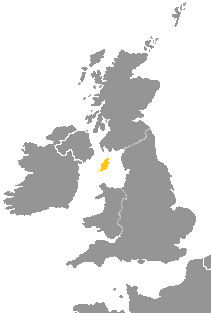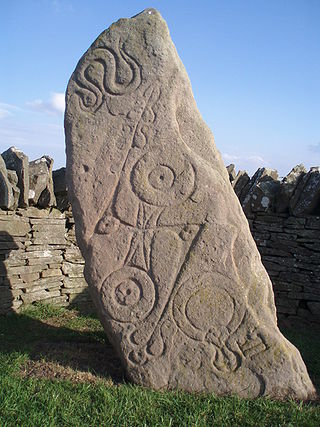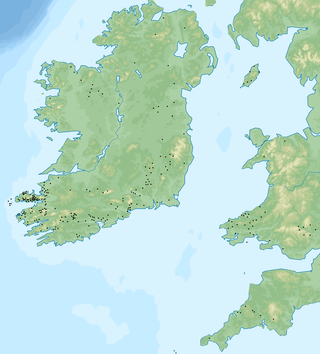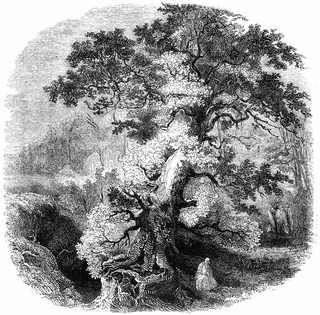
Manx, also known as Manx Gaelic, is a Gaelic language of the insular Celtic branch of the Celtic language family, itself a branch of the Indo-European language family. Manx is the historical language of the Manx people.

Ogham is an Early Medieval alphabet used primarily to write the early Irish language, and later the Old Irish language. There are roughly 400 surviving orthodox inscriptions on stone monuments throughout Ireland and western Britain, the bulk of which are in southern Munster. The largest number outside Ireland are in Pembrokeshire, Wales.

Primitive Irish or Archaic Irish, also called Proto-Goidelic, is the oldest known form of the Goidelic languages, and the ancestor of all languages within this family.

Sculptured stones is a name applied to carved stone monuments from the early Christian period excavated in various parts of the British Isles and Scandinavia. They document the conversion of these areas to Christianity

The Manx are an ethnic group originating on the Isle of Man, in the Irish Sea in Northern Europe. They belong to the diaspora of the Gaelic ethnolinguistic group, which now populate the parts of the British Isles and Ireland which once were the Kingdom of the Isles and Dál Riata. The Manx are governed through the Tynwald, the legislature of the island, which was introduced by Viking settlers over a thousand years ago. The native mythology and folklores of the Manx belong to the overall Celtic Mythology group, with Manannán mac Lir, the Mooinjer veggey, Buggane, Lhiannan-Shee, Ben-Varrey and the Moddey Dhoo being prominent mythological figures on the island. Their language, Manx Gaelic is derived from Middle Irish, which was introduced by settlers that colonised the island from Gaelic Ireland. However, Manx gaelic later developed in isolation and belongs as a separate Goidelic language of the Insular Celtic languages.
The forfeda are the "additional" letters of the Ogham alphabet, beyond the basic inventory of twenty signs. Their name derives from fid and the prefix for- ("additional"). The most important of these are five forfeda which were arranged in their own aicme or class, and were invented in the Old Irish period, several centuries after the peak of Ogham usage. They appear to have represented sounds felt to be missing from the original alphabet, maybe é(o), ó(i), ú(i), p and ch.

Roughly 400 known ogham inscriptions are on stone monuments scattered around the Irish Sea, the bulk of them dating to the fifth and sixth centuries. Their language is predominantly Primitive Irish, but a few examples record fragments of the Pictish language. Ogham itself is an Early Medieval form of alphabet or cipher, sometimes known as the "Celtic Tree Alphabet".

Andreas is one of the seventeen parishes of the Isle of Man. It is located in the north of the island in the sheading of Ayre. The main settlement in the parish in the village of Andreas, which is also known as Kirk Andreas.

The Ballaqueeney Ogham Stone is an early medieval memorial stone with an Ogham inscription. It was discovered at Ballaqueeney (Ballaquine) Isle of Man in 1874 by Reverend F. B. Grant during the process of excavating dirt for use as railroad ballast.
The Lunnasting stone is a stone bearing an ogham inscription, found at Lunnasting, Shetland and donated to the National Museum of Antiquities of Scotland in 1876.

Andreas or Kirk Andreas is a village on the Isle of Man, lying in the north of the island, 5 km from the island's second town, Ramsey. There is a large, and nowadays little used, airfield in the vicinity.

Celtic inscribed stones are stone monuments dating from 400 to 1000 AD which have inscriptions in Celtic or Latin text. These can be written in Ogham or Roman letters. Some stones have both Ogham and Roman inscriptions. The stones are found in Ireland, Scotland, Wales, Brittany, the Isle of Man, and parts of western England. Most seem to be grave-markers or memorials to a dead individual.

The Manx runestones were made by the Norse population on the Isle of Man during the Viking Age, mostly in the 10th century. Despite its small size, the Isle of Man stands out with many Viking Age runestones, in 1983 numbering as many as 26 surviving stones, which can be compared to 33 in all of Norway. So many of them may appear on the Isle of Man because of the merging of the immigrant Norse runestone tradition with the local Celtic tradition of raising high crosses.

Many types of trees found in the Celtic nations are considered to be sacred, whether as symbols, or due to medicinal properties, or because they are seen as the abode of particular nature spirits. Historically and in folklore, the respect given to trees varies in different parts of the Celtic world. On the Isle of Man, the phrase 'fairy tree' often refers to the elder tree. The medieval Welsh poem Cad Goddeu is believed to contain Celtic tree lore, possibly relating to the crann ogham, the branch of the ogham alphabet where tree names are used as mnemonic devices.

Ann Naddodsdóttir was possibly a daughter of Naddoddr, the Viking attributed with the discovery of Iceland.

Margam Stones Museum is a small Victorian schoolhouse near Port Talbot, South Wales, which now provides a home for one of the most important collections of Celtic stone crosses in Britain. All originally found within the locality of Margam, and mostly assembled as a collection in the 19th century, they provide enduring testimony to a Welsh Christian culture between the 6th and 16th centuries. The striking Cross of Conbelin is the most celebrated example. From around 1000 AD, it is a huge disc cross with Celtic interlace and plaitwork patterns, figurative scenes including a hunting scene, and inscriptions telling us who made it and who erected it. There are 17 early Christian stones, plus 11 memorials and other stones from the post-Norman periods. The museum is run by Cadw, the Welsh historic sites agency, and is close to Margam Abbey Church and the ruins of the Abbey buildings.

The Silchester Ogham stone is a pillar stone discovered at the Roman town on Calleva Atrebatum in Silchester, Hampshire during excavations in 1893. Thus far it remains the only one of its kind found in England, and the only ogham inscription in England east of Cornwall and Devon. The stone is held in a storage facility of Reading Museum in Reading, Berkshire.
Ballintaggart Ogham Stones is a collection of ogham stones forming a National Monument located in County Kerry, Ireland.

Knock y Doonee is a significant historical and archaeological site in the parish of Andreas on the northern coast of the Isle of Man. The site has been in ritual use for centuries. Archaeological excavations have uncovered a Christian keeill with a bilingual ogham stone and a Christian carved stone cross; and on a nearby hilltop a Viking Age boat burial.

Cashtal yn Ard(Castle of the Heights) is a Neolithic chambered tomb in Cornaa, in the parish of Maughold in the Isle of Man. It is situated on a low hill overlooking much of the surrounding parish of Maughold and across to the Lake District in England. The cairn was excavated in the 1930s and again in 1999. It is one of the most significant megalithic tombs on both the Isle of Man and Britain.
















